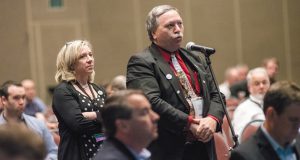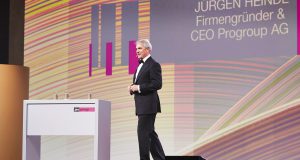This state-of-the-art pilot plant welcomes all industry stakeholders—suppliers, R&D institutions, and universities,
as well as producers.
MARK RUSHTON
What may be the world’s most modern pilot plant for tissue recently opened in Graz, Austria. Paper360° was given the opportunity to speak to Klaus Gissing, the man in charge of the new research center serving the global tissue industry.
 The PrimeLineTIAC—Tissue Innovation and Application Center—is about as modern a pilot plant as you can get for the worldwide industry. With a highly-automated system and a tissue machine capable of eight different configurations, the new pilot plant will allow all stakeholders of the tissue industry to conduct trials with state-of-the-art and new technologies.
The PrimeLineTIAC—Tissue Innovation and Application Center—is about as modern a pilot plant as you can get for the worldwide industry. With a highly-automated system and a tissue machine capable of eight different configurations, the new pilot plant will allow all stakeholders of the tissue industry to conduct trials with state-of-the-art and new technologies.
The facility has been launched by Andritz, which describes it as the “big dream come true for our tissue vision.” Klaus Gissing, VP of tissue at Andritz, explains: “Our customers often ask us, ‘What will the future look like when it comes to tissue technology?’ And we often ask ourselves, ‘Are our technologies, equipment, and experience fit for future challenges? What is needed for a tissue machine supplier to drive innovation? What do our customers expect from us?’”
The company’s answer was to build a unique tissue center where all tissue industry stakeholders could develop and implement the solutions of tomorrow. Says Gissing, “When we say stakeholders we do not only mean tissue producers. Our Tissue Innovation and Application Center here in Graz is the only center worldwide that opens its doors not only to tissue producers, but to suppliers, R&D institutions, and universities as well. This is a great way to combine practical and theoretical know-how and expertise and to network, improve, and develop solutions for the production of tissue.”
STAKEHOLDERS FROM ACROSS
THE INDUSTRY
In Gissing’s view, trials on commercial machines are not accurate enough and not viable due to high fiber and energy consumption, as well as possible production losses that lead to too-high costs. Trials at the PrimeLineTIAC pilot plant enable the production process on a completely new machine with new technology, and for a completely new end product. Target users are tissue producers, pulp suppliers, chemical suppliers, fabric and roll covers suppliers, converters, vacuum component suppliers, and R&D institutions.
The new pilot plant will allow all stakeholders of the tissue industry to conduct trials with technologies that have not yet been launched on the market, or with their own technologies. This gives them the chance to test these new concepts in advance and thus potentially gain a competitive advantage. Of course, all customer trials and the results are kept highly confidential.
Trials may be conducted to, for example, improve end product quality, or to optimize fibers and furnish, increase dryness, or reduce energy consumption. “The testing possibilities include trials for pulp, chemicals, refining and clothing, different press concepts—suction press and shoe press—hot air, steam, and vacuum concepts,” says Gissing. “The jumbo rolls that are produced under different conditions can be converted to enable a blind test with end-customers in their specific markets, if the customer requests.”
LABORATORY FACILITIES
For all these activities, laboratories are located alongside the production line. Experts working in the stock preparation laboratory are able to investigate a broad range of physical and chemical processes. The R&D work is focused on analyzing samples of various pulp types and sampling locations.
“The tissue machine laboratory enables evaluations regarding basis weight, caliper, tensile, formation, and softness. The laboratory is equipped with precision scales, oven, caliper tester, tensile tester, light box, and PPF (Pinch Pull Force) tester. In addition, tests can be conducted in the laboratories of the Technical University of Graz,” explains Gissing.
The tissue machine itself has eight different possible configurations that are fully supported by automation using Andritz’s latest industrial Internet of Things (IoT) technology. Gissing says: “The great challenge is not only to have eight configurations, but an automation system that enables and supports the production process on all eight configurations. This is how the PrimeControl E system was developed. Based on IoT technology, the systems’ three columns are enhanced operability and maintenance, embedded drive plus quality control, and eco monitoring. The whole pilot plant is equipped with an OPP (Optimization of Process Performance) system—the Andritz flagship product in the range of IoT solutions.”
Based on continuous developments in the three core technologies—Smart Sensors, Big Data, and Augmented Reality—OPP improves the performance of production systems in a mill by analyzing a huge amount of data collected throughout the systems. Says Gissing, “Once correlations have been identified by the system, control models can be derived and applied to stabilize or increase throughput and save resources. A holistic automation approach like OPP is dedicated for making improvements in three main areas: productivity, quality, and sustainability of production.”
Gissing concludes: “To realize a project of this magnitude sometimes leads you to the question, ‘Is this really the right path forward?’ But then you talk to customers, to suppliers, and to R&D experts and push it forward. In the end, when you stand in front of the tissue machine running smoothly—with technologies that are not even yet available on the market—then you know your vision has really come true!”
The Technology
Stock Preparation
All types of pulp—virgin fibers, recycled fibers, bagasse, bamboo, straw, synthetic fibers, BCTMP, and nanocellulose—can be treated in a continuous production line without intermediate long storage that might negatively influence fiber properties. The system is split into separate short and long fiber lines to allow best development of fibers depending on any possible furnish. The different fibers will be pulped in the FibreSolve FSV pulper with TMX agitator, which allows high slushing consistencies up to 7.5 percent; then fibers can be deflaked and refined in the cylindrical Papillon refiner CS, where they are treated in the cylindrical refining zone much more gently.
The separate stock components for short fiber as well as for long fiber are then mixed in two Andritz ShortFlow blending systems. The approach-flow system follows, with two ModuScreens HBE with best protection and lowest pulsation. Excess water from the tissue machine is clarified in a microflotation system and used partly as shower water. There is also a MicraScreen with fine-slotted bow screens and automatic self-cleaning device. The sludge, with a consistency of approximately 2 percent, is dewatered in the Reject Compactor ReCo-L, which is able to thicken from low consistencies up to a dryness suitable for disposal.
The Tissue Machine
The new TIAC can be operated in eight different tissue machine configurations, from conventional tissue on a crescent former with SPR or the new XT Evo shoe press, to conventional enhanced VRT (vertical crescent former), textured TEX and premium structured produced on TAD and VTAD configurations. An overview of the tissue machine:
• Design speed: 2500 m/min
• Headbox: 1-, 2-, 3-layer configuration
• Former: CrescentFormer, TwinWire former
• Pre-Dryer: Two TAD drums, 14 ft.
• Hood: TAD hood
• Press: Suction press, shoe press
• Dryer: Steel Yankee, 16 ft.
• Hood: High-temperature hood
• Sheet run: Passive/active foil
• Reel: Centerwind reel
Automation
The eight configurations on the tissue machine are supported fully by a PrimeControl E automation system that allows flexibility by supporting three functional areas: enhanced operability and maintenance, embedded drive and quality control system, and eco monitoring (resource management system). These focused “E” areas are enabled by a set of integrated functionalities that lead to proper results tailored to the specific needs applied. The configuration can be controlled by mobile device (such as a smartphone or tablet), in the main control room, or by remote control. The ensemble of the functional bundles is an extremely modern control system for tissue plants; it also supports in reconfiguration and pre-production phases, as well as during the whole operation phase.
Pumps
The TIAC has been equipped with high-quality, multi-functional Andritz process pumps. They fulfill three different purposes within the production process: transportation of all liquids, operation in the stock preparation process, and drainage. The core pump, however, is an Andritz headbox pump with the lowest pulsation, which is achieved by offset rotor blades developed especially for tissue production. With efficiencies beyond 90 percent, it helps to save valuable energy, and conveys stock suspensions with consistencies of up to 2 percent.
Each of these pumps is equipped with a sensor concept that is unique in pilot plants worldwide. It allows the facility not only to control the operating mode of the pumps, but also to obtain important information on the process and on operation under different conditions.
The tissue machine has eight different possible configurations that are supported by automation using industrial Internet of Things (IoT) technology.
The Andritz PrimeLine Tissue Innovation and Application Center in Graz, Austria.
 Klaus Gissing, vice president tissue, Andritz.
Klaus Gissing, vice president tissue, Andritz.
 Paper 360
Paper 360


